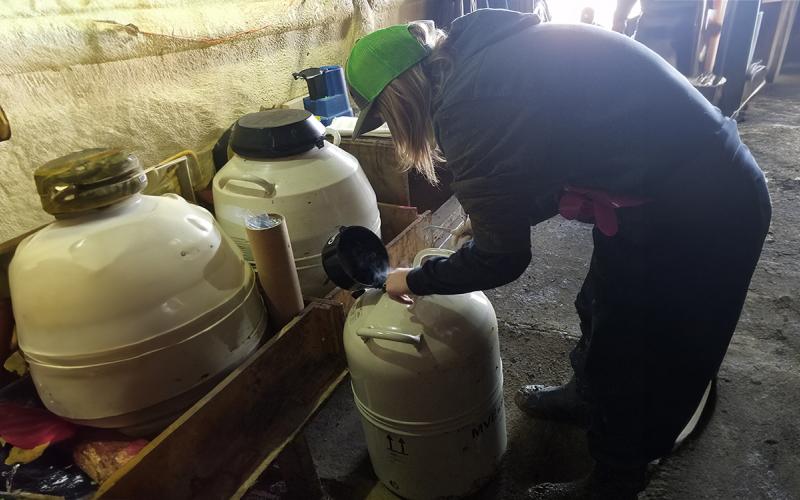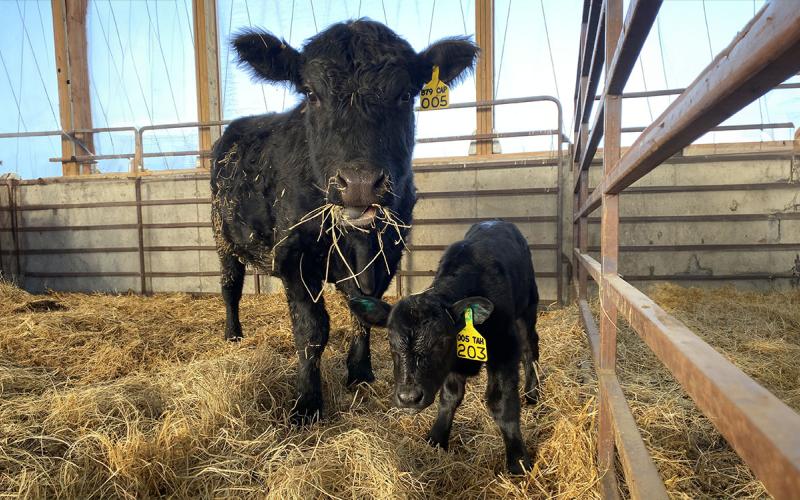Originally written by Taylor Grussing, former SDSU Extension Cow/Calf Field Specialist.
Replacement heifers are the most common group of females on the ranch to be artificially inseminated (3.9 %; NAHMS, 2009). The reason is because of their close proximity to the ranch where they are frequently fed in dry lot or supplemented, making it more convenient for producers. The 2016 Beef Heifer estrous synchronization protocols were developed by the Beef Reproductive Task Force and can be as simple, or complex as a producer chooses. The advantages of using these protocols include females becoming pregnant earlier in the breeding season leading to earlier calving in the subsequent calving season, weaning heavier calves and the potential to continue rebreeding early each year. Therefore, it is an excellent idea for producers at the very least to implement an estrous synchronization program into their heifer development operation and artificial insemination (AI) if possible.
SDSU Extension Cow/Calf Field Specialist, Warren Rusche outlined the aspects involved with successful use of MGA to synchronize heifers for breeding season. Another option available for heifer (and cow) synchronization is use of a CIDR (Controlled Internal Drug Release). Like MGA, the CIDR serves as a transport mechanism for the hormone progesterone to be utilized by the female in attempts to modify her reproductive cycle for breeding. Progesterone is the hormone that blocks estrus and is also responsible for maintaining pregnancy. A CIDR is a “T” shaped rubber device that contains 1.38 grams of progesterone encased in rubber molded over the nylon spine.
CIDR Advantages
The primary advantages of using the CIDR are that it is simple to insert and it works to control estrus in cycling and prepubertal heifers, as well as cycling and anestrous cows. Protocols without progestins do not stimulate estrous cycles in prepubertal and anestrous females; therefore, CIDRs are the best route if producers do not know the cycling status of the herd or if trying to shorten the postpartum interval. In addition, the CIDR can be used in a variety of protocols giving the producer more choices to use either a short-term or long term protocol that best fits into their schedule.
CIDR Disadvantages
Some disadvantages of CIDRs include the expense and labor required for trips through the chute. CIDRs cost ~$11/insert and are labeled for one time use only. In addition, in contrast to MGA, heifers must make 1 or 2 extra trips (in addition to breeding) through the chute for insertion and removal of the CIDR. However, by using CIDR protocols producers can be confident the correct dosage of progestin is delivered each day without starting the feeder wagon or worrying about delivering a consistent dose via MGA.
Which CIDR protocol is best?
The key to success with any estrus synchronization protocol, including CIDRs, is compliance. There are different CIDR protocols for heifers and cows, and it is important to follow the correct protocol and timeline based on the age of the female you are dealing with. For example, in the 5-day CO-Synch + CIDR protocol, heifers are to be bred at 60 ± 4 hr. versus cows bred at 72 ± 2 hr. after CIDR removal. These time differences are based on differences in hormones and time of ovulation between heifers and cows, with protocols designed to breed at a time that will yield the most successful results. An operation’s available labor, facilities, and experience will also dictate which protocol that they can most efficiently carry out in an efficient, timely manner to be successful, whether it’s heat detection, heat detection + timed AI or fixed-time AI (FTAI).
Specifically within the heifer protocols, CIDRs can be used for 5, 6, 7 or 14 days. When utilizing the 14-day CIDR it is important to remember to never breed females on the first estrus after CIDR removal due to persistent, aged follicles which are likely less fertile and would not return favorable results. A study done by Bridges and others published in the Journal of Animal Science in 2014 compared pregnancy rates of beef heifers after exposure to 3 different FTAI protocols: 5-day CO-Synch + CIDR, PG 6-day CIDR, or 14-day CIDR – PG protocol. Differences in puberty were seen between treatments due to more heifers in the 14-day protocol being prepubertal at treatment initiation. However, pregnancy rates between the 3 FTAI treatments were not different resulting in 62.6%, 56.9%, and 53.3% for 5d-CO-Synch+CIDR, PG-6dCIDR, and 14dCIDR-PG, respectively. Puberty attainment was determined to have the most effect on pregnancy success. Starting heifers off with proper nutrition and health management to have them reach puberty prior to estrus synchronization and AI, will assist producers with a successful breeding season.
Download the free Estrus Synchronization Planner to develop a complete synchronization and breeding calendar designed specific to your protocol, breeding date and herd size for heifers and cows.
Reference:
Bridges, G. A., S. L. Lake, S. G. Kruse, S. L. Bird, B. J. Funnell, R. Arias, J. A. Walker, J. K. Grant, and G. A. Perry. 2014. Comparison of three CIDR-based fixed-time AI protocols in beef heifers. J. Anim. Sci. 92: 3127 – 3133.


